The Qualcomm Snapdragon 820 Performance Preview: Meet Kryo
by Ryan Smith & Andrei Frumusanu on December 10, 2015 11:00 AM EST- Posted in
- SoCs
- Snapdragon
- Qualcomm
- Snapdragon 820
GPU Performance
Shifting gears, let’s take a look at GPU performance. As we mentioned earlier, Qualcomm isn’t disclosing much about this GPU other than that it packs quite a bit more computational power than its predecessor and should be quite a bit faster in the process. This points to a potentially significant architectural shift, but that determination will have to wait for another time.
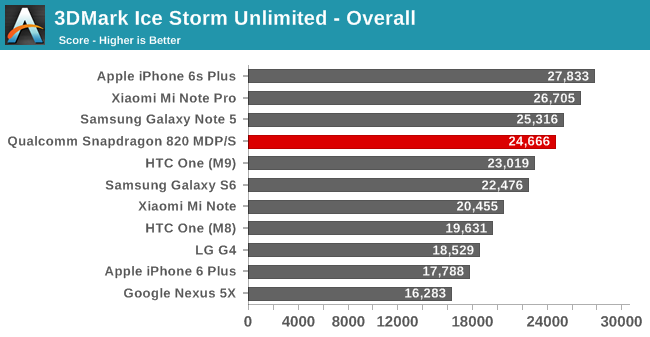
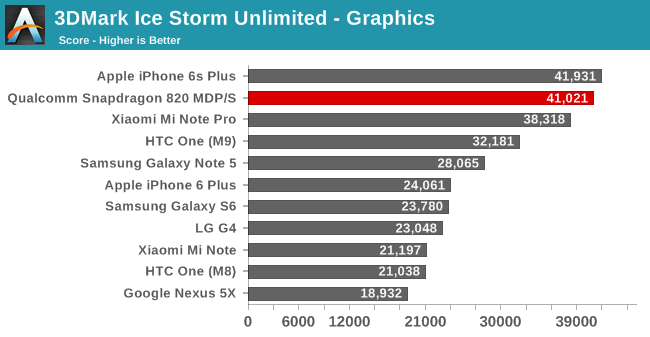
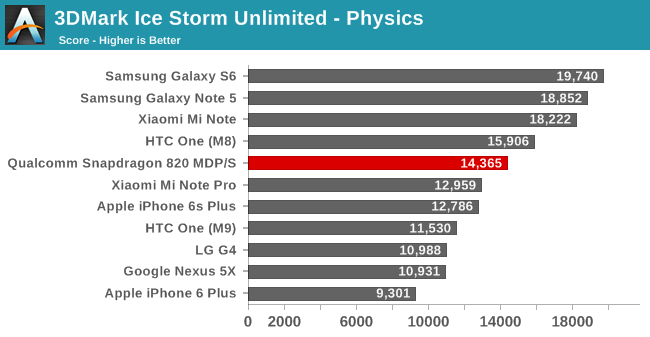
Starting with 3DMark Ice Storm Unlimited, the performance honestly doesn’t start out great. The overall score is significantly influenced by the physics score, which in turn is more concerned with the number of cores and their throughput on simple code than the ability to extract complex IPC. As a result the 4 CPU core 820 simply can’t catch up with the likes of the Samsung devices and their high-clocked big.LITTLE configurations. On the other hand the graphics score makes this the fastest Android phone to date, though relative to the 810 Mi Note Pro, perhaps not by a ton. Ultimately as this is an OpenGL ES 2.x test it’s not the most strenuous of tests these days, and comments from Qualcomm indicate that it may be a CPU-limited test on 820.
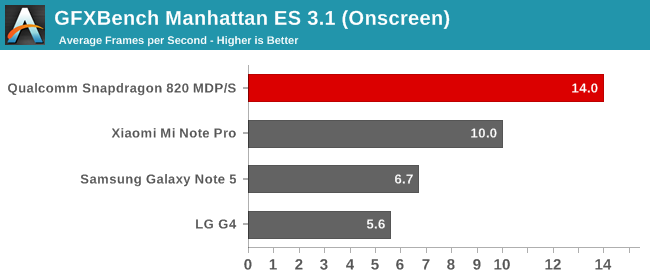
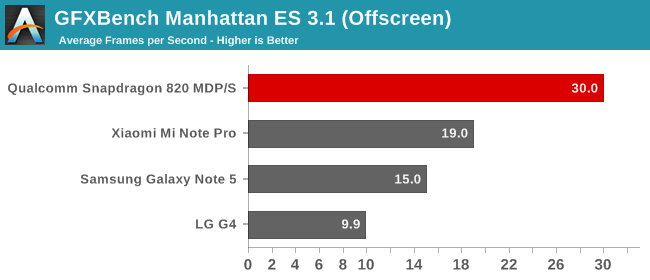
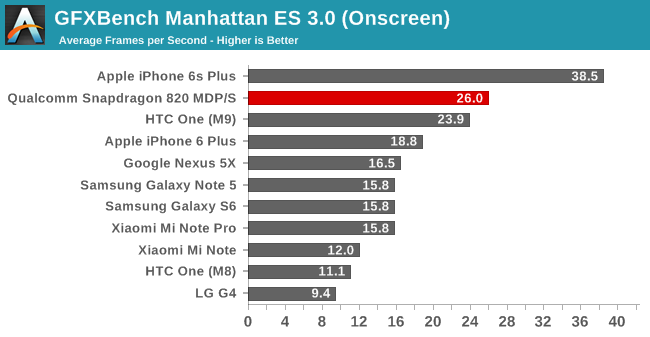
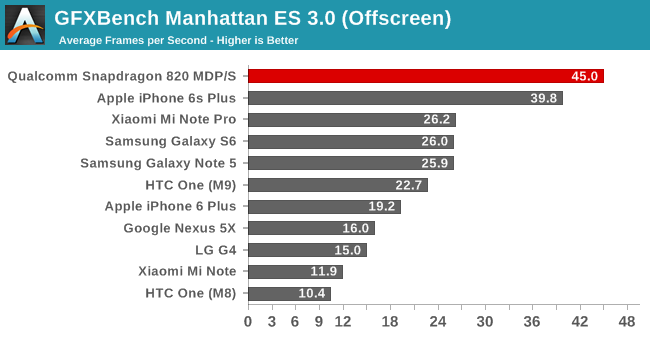
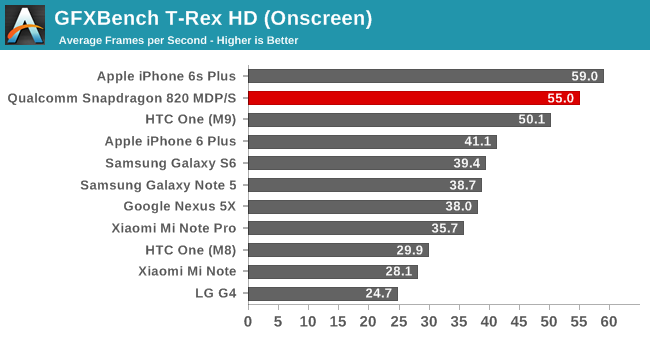
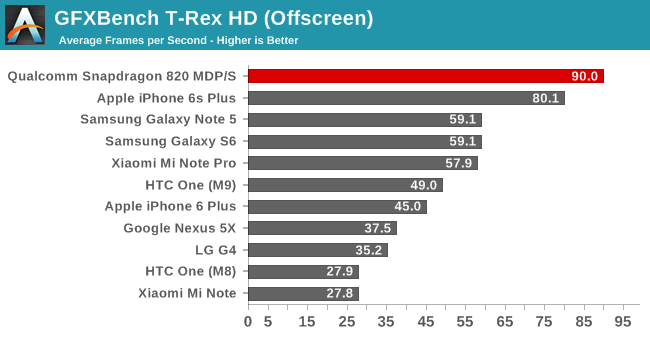
GFXBench on the other hand shows some massive gains for the 820 relative to any other Android device. In offscreen rendering mode, all 3 game tests – Manhattan ES 3.1, Manhattan ES 3.0, and T-Rex HD – put the 820 MDP/S as being 52% (or more) faster than the next-fastest Android device, either the 810 based Mi Note Pro or the Exynos 7420 based Samsung Galaxy Note 5. The single biggest jump we see is with Manhattan ES 3.0 at 72%, while the ES 3.1 version dials that back down to 52%. Even the iPhone 6s Plus, well known for its powerful GPU, is handily and consistently surpassed by the 820 here. Only due to the 6s Plus’s lower rendering resolution of 2208x1242 does it surpass the MDP/S in onscreen tests, as the latter needs to render at 2560x1600 (~50% more pixels). Qualcomm was aiming for some big GPU performance gains here and so far they are delivering.

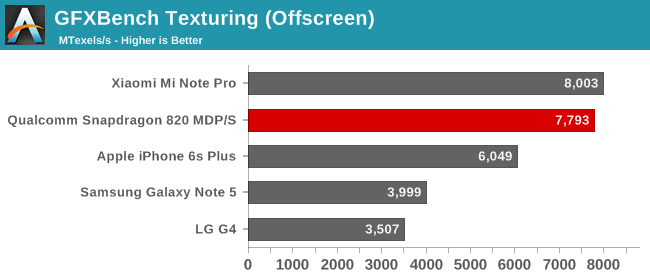
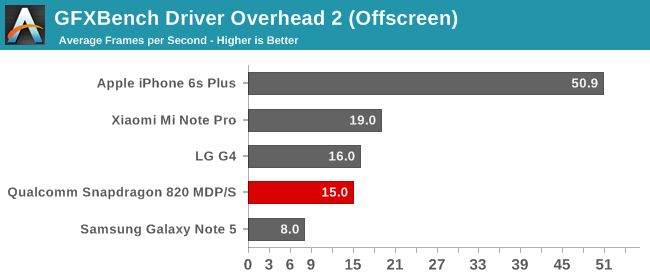
Curiously, GFXBench’s synthetic feature tests don’t show the same gains. Offscreen ALU performance is only slightly improved over the 810 (10%) or in the case of texturing is an outright regression. None-the-less full gaming performance is clearly in the 820’s favor. I’ve long suspected that the Adreno 430 GPU in the 810 had some kind of architectural bottleneck – perhaps an ALU/texture array that was difficult to fully utilize – and what we’re seeing here would back up that claim, as if that was the case then correcting it would have allowed Qualcomm to significantly boost their rendering performance while only barely changing their synthetic performance. Otherwise I find it a bit surprising that the driver overhead score is a bit worse on 820 than 810, which may be a result of the immature GPU drivers on this early device.










146 Comments
View All Comments
ws3 - Saturday, December 12, 2015 - link
Oops - "something me" should be "someone"toyotabedzrock - Friday, December 11, 2015 - link
Please tell me they are really not expecting that 3gb will be enough.Exynostein - Friday, December 11, 2015 - link
2017, Qualcomm is still very difficult, Apple will use A10, Samsung, as far as I know, Samsung's Exynos M2 architecture than the IPC upgrade Exynos M1 great, S820 and S830 compared to little change in architecture , but Samsung's 10nm LPE process. In fact, the biggest reason Samsung Qualcomm processor it is CDMA, Qualcomm CDMA grasp the vast majority of patents, almost a monopoly, and only China and the US presence CDMA, so Samsung had to use these two regions S820, otherwise, if Exynos8890 need plug-CDMA baseband, which will add significant costs.bushgreen - Saturday, December 12, 2015 - link
This consumes 30% less power than snapdragon 810. 810 throttles 50%. So 820 will still throttle 20%. Better to use only 2 cores like apple so it wont throttle at all and consume less power. 2 of these cores is enough.UtilityMax - Saturday, December 12, 2015 - link
I find that my SD800 based LG G2 runs smoothly most of the time, while barely getting hot or sipping battery. So will be impressive and more than sufficient if SD820 based smartphones have an SoC that's for many purposes 200% faster than the old SD800/SD801 parts without overheating or using too much power. I think we are close to be intering the smartphone era when, just like with the PCs, the CPU is fast enough for the most of the ordinary users, but what now matters is the sum of all parts: the screen, the camera, the battery, the design, and the build quality. In this sense in my opinion, the Oneplus X is probably one of the best phones of the year because it delivers all of this in a $250 dollar package.Mondozai - Saturday, December 12, 2015 - link
Im using SD800 in my 1520. Its already fast enough. Although I wonder how much of that is due to the smoothness of WP.TelstarTOS - Saturday, December 12, 2015 - link
Good, but not good enough.Rixxos - Sunday, December 13, 2015 - link
Not good enough for what?jruhe - Sunday, December 13, 2015 - link
A72 (Amazon Fire TV 2) vs. Kyro @Geekbenchhttps://browser.primatelabs.com/geekbench3/compare...
milli - Monday, December 14, 2015 - link
The Kryo scores you use, are very early results.I made a comparison between the Amazon Fire TV 2 and the 820, using Anand's numbers.
http://i.imgur.com/O3L6bQM.png